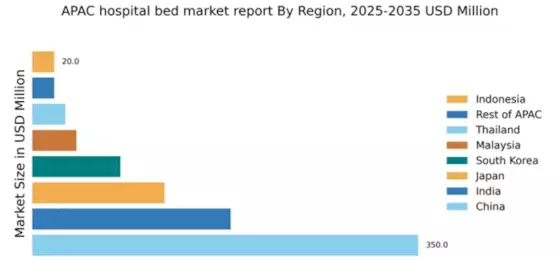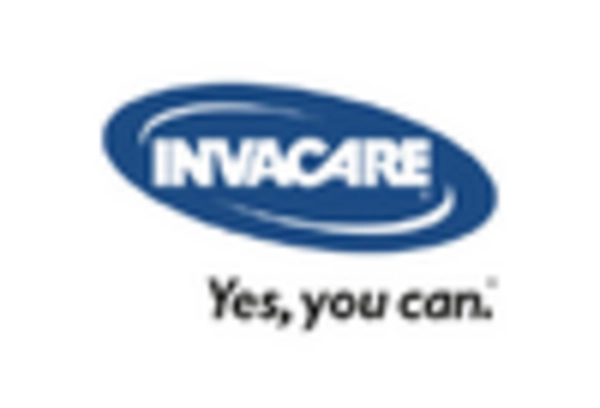China : Rapid Expansion in Healthcare Infrastructure
China holds a commanding market share of 43.75% in the APAC hospital bed market, valued at $350.0 million. Key growth drivers include an aging population, increasing healthcare expenditure, and government initiatives aimed at enhancing healthcare access. Demand trends show a shift towards advanced hospital beds with smart technology features. Regulatory policies support the import of high-quality medical equipment, while significant investments in healthcare infrastructure bolster industrial development.
India : Healthcare Reforms Driving Demand
India accounts for 22.5% of the APAC market, valued at $180.0 million. The growth is driven by rising disposable incomes, urbanization, and government healthcare reforms. Demand for hospital beds is increasing, particularly in tier-2 and tier-3 cities, as healthcare facilities expand. The government’s Ayushman Bharat scheme aims to provide affordable healthcare, further stimulating market growth. Regulatory frameworks are evolving to ensure quality standards in medical equipment.
Japan : Focus on Quality and Innovation
Japan holds a market share of 15% in the APAC hospital bed market, valued at $120.0 million. The aging population and a strong emphasis on quality healthcare drive demand for advanced hospital beds. Innovations in smart beds and patient monitoring systems are gaining traction. Government policies support the integration of technology in healthcare, while stringent regulations ensure high standards. The market is characterized by a preference for premium products and services.
South Korea : Innovative Healthcare Solutions on Rise
South Korea represents 10% of the APAC market, valued at $80.0 million. The growth is fueled by technological advancements and a robust healthcare system. Increasing investments in smart hospital beds and telemedicine are reshaping the market landscape. Government initiatives promote healthcare innovation, while regulatory bodies ensure compliance with international standards. The competitive landscape features both local and international players focusing on high-tech solutions.
Malaysia : Investment in Medical Infrastructure
Malaysia captures 5% of the APAC market, valued at $40.0 million. The healthcare sector is expanding due to rising health awareness and government investments in medical infrastructure. Demand for hospital beds is increasing, particularly in urban areas like Kuala Lumpur and Penang. Regulatory policies are becoming more favorable for foreign investments, enhancing market dynamics. Local players are collaborating with international firms to improve product offerings.
Thailand : Rising Demand for Quality Care
Thailand holds a 3.75% market share, valued at $30.0 million. The growth is driven by an increasing number of private hospitals and healthcare facilities. Urban centers like Bangkok are seeing a surge in demand for advanced hospital beds. Government initiatives focus on improving healthcare access and quality. The competitive landscape includes both local manufacturers and international brands, with a focus on affordability and quality.
Indonesia : Emerging Demand for Hospital Beds
Indonesia accounts for 2.5% of the APAC market, valued at $20.0 million. The healthcare sector is evolving, driven by a growing population and increasing health awareness. Demand for hospital beds is rising, particularly in urban areas like Jakarta. Government initiatives aim to enhance healthcare infrastructure, while regulatory frameworks are gradually improving. The market is characterized by a mix of local and international players, focusing on cost-effective solutions.
Rest of APAC : Varied Demand Across Sub-regions
The Rest of APAC holds a 2.5% market share, valued at $20.0 million. This segment includes various countries with unique healthcare challenges and opportunities. Demand for hospital beds varies significantly, influenced by local healthcare policies and economic conditions. Regulatory environments are diverse, affecting market entry strategies for international players. The competitive landscape is fragmented, with local manufacturers catering to specific regional needs.


















Leave a Comment